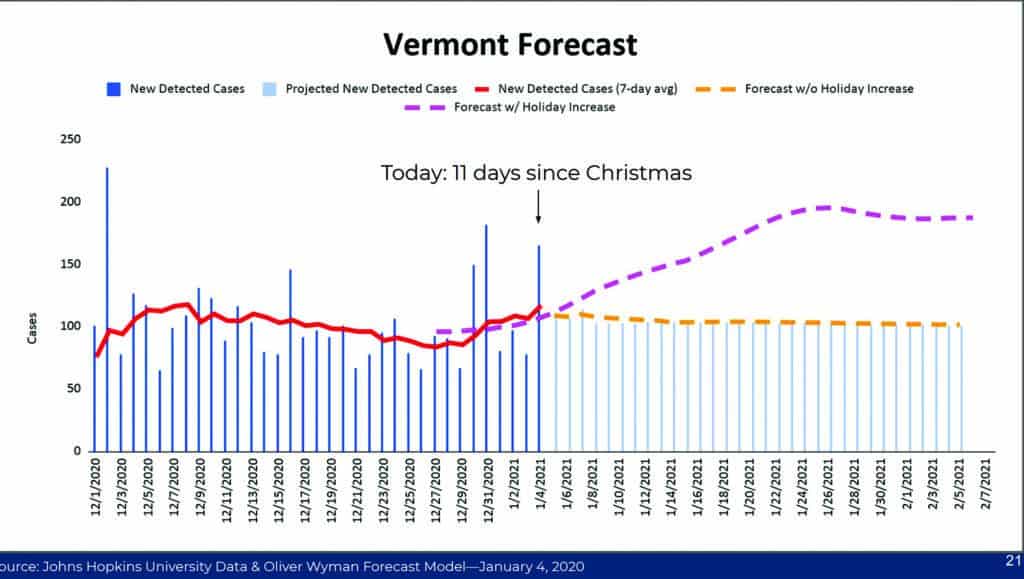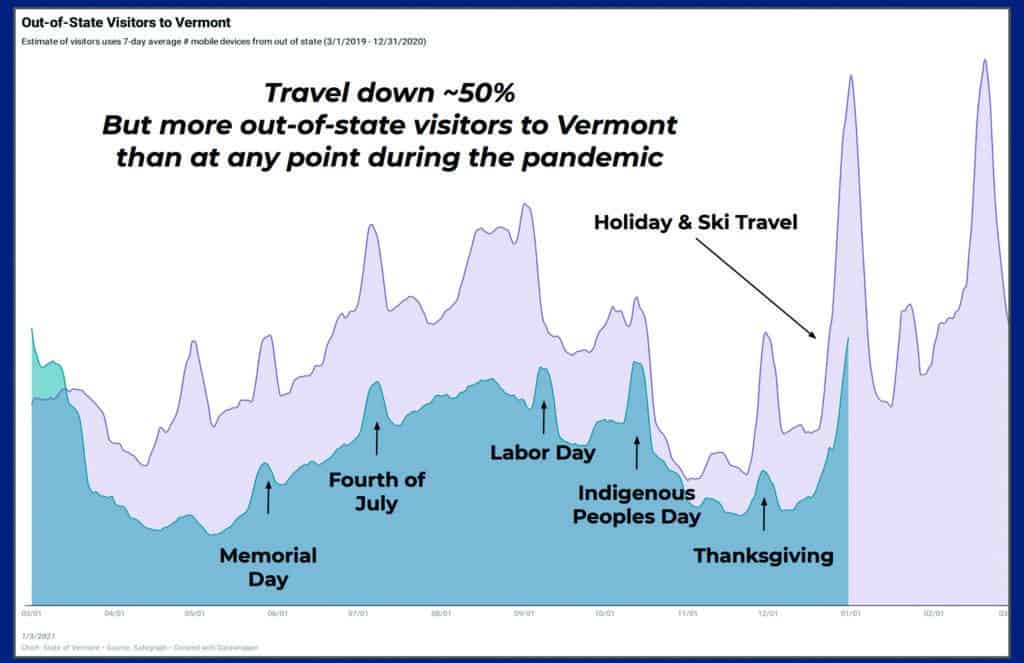State officials urge all Vermonters who recently gathered with others or traveled to get tested
By Polly Mikula

Governor Phil Scott and State Health Commissioner Dr. Mark Levine encouraged Vermonters to go get a Covid-19 test, at the regular press conference Tuesday, Jan. 5.
The governor had temporarily permitted households to gather with one trusted family from Dec. 23 – Jan. 2, but encouraged all who did that to get tested seven days after.
Tuesday marked 11 days after Christmas, but testing rates have dropped 14% regionally. Decreased testing coupled with increased case counts have caused the positivity rate to increase to over 10% regionally and 2.63% in Vermont — indicating a potentially concerning trend.
But Michael S. Pieciak, commissioner of the Dept. of Financial Regulation, cautioned that data around the holidays is still uncertain. He noted that asymptomatic people are less likely to get tested over the holidays, and that there could be a lag in processing data as well.
Because of that, he said, “It’s too early to know the full impact from the holidays,” and cautioned Vermonters “to avoid making any conclusions until the data becomes more certain.”
Levine added, “Any spike would likely be known in the coming week or so. I expect to have a more thorough analysis on Friday after a few more days of data.”
While case data continues to be analyzed, mobility data can be looked at as an early indicator.
While travel into Vermont over Christmas was down approximately 50% compared to last year, it was still the highest volume since the pandemic begun.
When asked if ski areas and other tourist attractions were contributing to the uptick in travel and, thereby, the spread of the virus, Scott said: “We have not determined any direct correlation between ski areas and an increase of cases.” He acknowledged that enforcement was difficult but noted, “We’ve asked ski areas to do this for us and, so far, they’ve done their part.”

Tuesday, Pieciak showed a range of future projections for case growth in Vermont after the holiday week. One projection assumed no holiday impact, in which Covid cases continued at the current plateau of approximately 100 cases per day. The other showed a holiday impact consistent with increases other states experienced after the Thanksgiving holiday. This latter projection shows cases continuing to rise through the end of January and plateauing in early February at an average of about 200 new cases per day — effectively doubling the current average daily case count.
Even at that high projection, however, Pieciak said the state’s hospital and ICU capacity is forecast to be okay.
As always, Pieciak reminded Vermonters that forecasts can be positively affected by Vermonters better adhering to state guidance — and getting tested if they gathered with others or traveled out of state.
Levine echoed and amplified that statement, saying: “The most important thing I want to impress upon people at this time, is to get tested! Whether you gathered with a single household, whether you broke the rules and saw more people over the holidays, or if you had a potential exposure to someone who has Covid. Please get tested. There’s still time to protect our loved ones and our communities. Remember this virus spreads easily from person to person and you can spread the virus even if you don’t have symptoms. Testing is really the only tool we have to exercise what we’re calling our containment strategy.”
Vermonters without Covid symptoms can get tested at more than 15 regular locations throughout the state, Levine added. And most sites allow individuals to take their own sample using a short swab in the nostrils. “It’s really very quick, it’s easy and it’s free,” Levine said.
Vermonters can register for a test by visiting healthvermont.gov/covid-19/testing.
“The other part of an effective containment strategy is knowing who you were in close contact with,” Levine added. “That means of course, within 6six feet for a total of 15 minutes in a 24 hour period… please know that contact tracers do not enforce rules and you’re not going to get into trouble, the key is to make sure we have the information we need to protect Vermonters. Testing and tracing can really stop the virus in its tracks, but only when we know who has it.
“The more we can test now and prevent the virus from spreading from one unsuspecting Vermonter to another, the more we can reduce the activity of the virus in our state while at the same time providing more and more doses of the vaccine over the winter and spring. Starting out at a low level of virus, while vaccination is ramping up is part of an important strategy for returning as nearly as possible to life as it was before Covid-19,” he said.
When asked about the new variant of Covid-19, Levine said that while Vermont has not see any of those cases yet, he “fully expects to.” Especially since yesterday a case was reported in Saratoga, New York.
He said if the new variant becomes prevalent in U.S. as it has in Britain, we will need to “redouble our efforts.”

Vaccination update
As of Tuesday, Jan. 6, 17,653 doses of Covid-19 vaccine have been administered in Vermont, with about half of those going to the Emergency Medical Service (EMS) workforce and one-quarter administered to healthcare workers, Levine said. The state has received about 30,000 doses.
“We’re doing better than most states at this point,” Scott said. “But it’s never good enough… we’ll get better, I’m confident in that.”
“The national rate is 20-25% of shipped vaccine getting into arms, so we’re more than doubling that,” Levine noted, explaining that some lag time is necessary as transportation, coordination and scheduling are required between receiving the vaccine and administering it.
At a rate of over 50% administered, Vermont ranks among the top states in the nation, added Mike Smith, secretary of the Agency Human Services. Once the federal vaccine shipments become more consistent with timing and quantities received and the state moves into the next phase of vaccinating Vermonters based on age bands, “I think you’ll see the pace pick up significantly,” Smith said.
After priority group 1a (which prioritizes healthcare workers, EMS, and residents and workers at long term care facilities), the state will begin vaccinating Vermonters 75 years or older, followed by those age 65-74, and then those under 65 with high risk conditions (which the state is still defining.)
Levine said the soonest he expects to be vaccinating by age bracket is “later this month at earliest, depending on fed allocations.”
“Please do not write or call us to get yourself or your loved ones on the list,” Levine said. “When it’s your turn the state will let you know.”
While awaiting vaccination, Scott implored Vermonters to remain vigilant.
“In the summer we went months without any deaths and case counts in the single digits but today we rarely go a day without someone dying from this virus,” Scott said. “We’re asking you to be compassionate. Our guidance has a proven track record when it comes to mitigating the spread of this virus. But it only works if we continue to follow it. You’ve been doing this for so long out of empathy for one and other and the most vulnerable members of our communities. So if we stick to what we know works, along with our vaccination plan, I’m confident that we’ll come out of this pandemic stronger and healthier than any other state in the country.”




